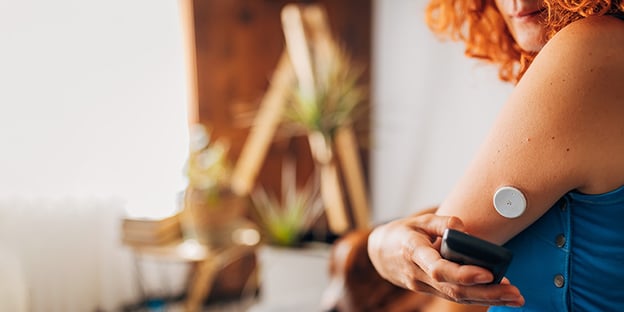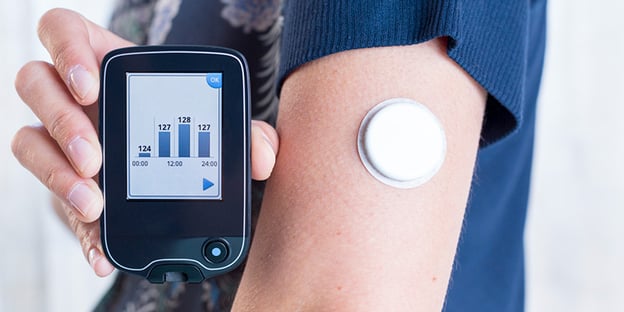Managing blood sugar levels is a constant challenge for people with diabetes. However, the game-changing technology within continuous glucose monitoring (CGM) systems now makes blood sugar control easier and more effective. Not only does it provide continuous monitoring, but it also improves the type of data available so that patients, their caregivers, and their clinicians can ensure the most appropriate lifestyle and care for each individual.
Central to this improved data is the ability to track blood sugar levels over a longer period of time. For a better understanding, let’s look at how blood sugar management has changed.
Understanding Traditional Blood Sugar Monitoring
Since the 1970s, clinicians have been relying on A1C tests and intermittent fingerstick measurements to track blood sugar levels.
What Is A1C?
A1C is a blood test that reflects average blood sugar levels over a 90-day period and has traditionally been the primary tool for managing diabetes and assessing how well a patient’s treatment plan is working. Specifically, A1C measures how much hemoglobin in red blood cells has attached sugar. Because the lifespan of red blood cells is about two or three months, an A1C test applies to average blood sugar levels during that time.
The American Diabetes Association recommends that most diabetic patients should have an A1C level of less than 7%. However, patients should consult their health care provider for the specific target that is right for them. Target A1C levels can vary depending on individual factors, such as age, overall health, and the presence of other medical conditions.
By keeping their A1C within the target range, patients have a better chance of reducing their risk of complications and maintaining overall health.
However, A1C does have its limitations.
A1C does not reflect real-time insights into the continuous fluctuations of blood sugar levels throughout the day and night, which are crucial for effective diabetes management. Without this insight, it’s much easier to miss the trends and warning signs that can be leveraged to improve patients’ overall quality of life.
In recent years, research has shown that Time in Range (TIR) is a more comprehensive metric to evaluate blood sugar control.
Understanding Time in Range (TIR)
Time in Range (TIR) refers to the percentage of time a patient’s blood sugar levels remain within a target range for a 24-hour period of time. For many diabetic patients, that range is 70 to 180 mg/dL (3.9 to 10 mmol/L). Again, target blood sugar level for any patient is something that should be discussed with their health care provider. Similar to A1C, this target depends on individual circumstances and factors such as age, overall health, and specific diabetes management goals.
The TIR percentage that most patients aim for is 70%. That means their blood sugar level is within their target range 70% of the time for a 24-hour period. A higher TIR has been associated with improved diabetes outcomes and a reduced risk of complications. It helps minimize the risk of both hypoglycemia (low blood sugar) and hyperglycemia (high blood sugar).
Why Is TIR Better for Blood Sugar Management?
TIR provides a more comprehensive view of a patient’s quality of life and a better understanding of how well they are managing their diabetes.
For example, an A1C might appear to be perfect because it measures within range. What A1C doesn’t take into account is fluctuation, or what’s called glycemic variability. TIR may reveal that the patient experiences low blood sugar at the same time every day, causing them distress and even creating a potential medical emergency.
With TIR, patients and their health care providers can track trends and other insights that determine whether a treatment plan – including medication, diet, and physical activity – is effectively keeping blood sugar levels within a healthy range.
The technology that has been proven to improve TIR for diabetic patients is continuous glucose monitoring (CGM).
The Role of CGM Systems in Blood Sugar Management
CGM systems have revolutionized the way patients manage their blood sugar levels. These cutting-edge systems have three main components:
- A disposable sensor with a small, hairlike filament is placed on the skin to monitor glucose levels day and night, providing accurate and real-time data.
- A transmitter is wirelessly connected, which sends glucose readings from the sensor to a compatible smart device. Because it’s water-resistant, patients can wear it while bathing or swimming without interruption.
- Patients can use their smartphones and smartwatches as receivers, which act as a display screen to show current glucose levels, trends, and alerts.
CGM systems offer many benefits, including:
Enhanced Hypoglycemia and Hyperglycemia Alerts
CGM systems provide timely notifications and alerts when blood sugar levels fall too low (hypoglycemia) or rise too high (hyperglycemia). When patients experience low blood sugar, it can cause significant physical and mental deficits, where high blood sugar can make patients tired, thirsty, hungry, and irritable.
With CGM technology, patients can identify personalized target ranges for glucose levels where they receive an alert before experiencing an episode. This proactive intervention allows patients to take immediate action, preventing potentially dangerous situations.
Reduced Glycemic Variability
When a patient’s blood sugar level is continuously fluctuating, it can make them quite uncomfortable. With CGMs, patients receive continuous, real-time data, highlighting fluctuations that would otherwise go unnoticed with traditional monitoring methods like A1C. This allows patients and their health care providers to make changes to their treatment plan with the goal of minimizing these variations and improving their overall health.
Allowing Caregivers to Help Monitor Blood Sugar
CGM systems are also advantageous because they allow caregivers to participate in monitoring a patient’s diabetes – something that is especially important for older adults and young children. CGMs transmit data to any smartphone, which makes it easy to remotely track and monitor blood glucose levels.
Better Quality of Life
Beyond blood sugar management, CGM systems have a significant impact on the quality of life for patients with diabetes. First, they no longer need to perform frequent fingerstick measurements, which can be a nuisance and, for some patients, embarrassing. Because CGMs are worn on the body, they can’t be forgotten, alleviating the burden of having to remember to bring a device with them wherever they go. This offers much more freedom for patients to focus on enjoying life.
Choosing the Right Continuous Glucose Monitoring System
Total Medical Supply offers patients two types of CGM systems.
The Dexcom G6 CGM has a sensor that is typically inserted on the abdomen and can be worn for 10 days before it must be replaced.
The Dexcom G7 CGM is inserted into the back of the upper arm, the abdomen, or, for children ages 2-17, on the upper buttocks. It’s also 60 percent smaller than the G6.
The FreeStyle Libre 2 CGM has a sensor that is usually worn on the back of the arm and can be worn for 14 days before replacement.
The FreeStyle Libre 3 CGM is a one-piece system that can be worn for up to 14 days.
All systems feature trend arrows that help patients identify whether their glucose is rising, falling, or staying stable. The Dexcom G6 has seven arrows, and the FreeStyle Libre 2 has five.
Continuous glucose monitoring systems have transformed blood sugar management by providing real-time insights, improving TIR, and reducing glycemic variability. With the ability to detect hypo- and hyperglycemic events promptly, make informed decisions, and achieve a more stable blood sugar profile, CGM systems can help patients take control of their diabetes management.
Find out if a CGM is right for you!







